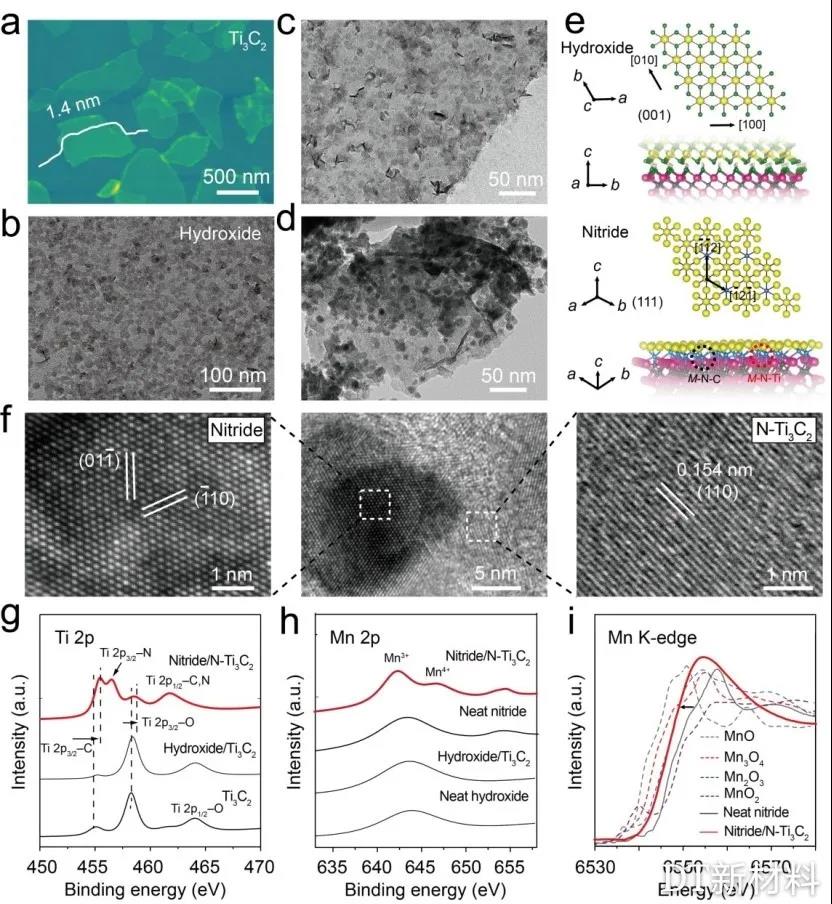Nano Letters: MXene stabilizes molecular thickness nitride nanosheets to achieve a highly efficient dual function catalyst for fiber-structured zinc air batteries!
QQ Academic Group: 1092348845
Detailed
【Research Background】
Zinc air batteries have a theoretical specific energy of up to 1084 Wh kg-1 and low production costs and are considered as one of the ideal choices for portable and wearable energy devices. The basic working principle of a zinc air battery is:

That is, the battery system undergoes an OER reaction during charging, and an ORR reaction occurs during discharging. In order to overcome the kinetic difficulties and higher energy barriers in the reaction process, noble metal catalysts are widely used, however, their single catalytic performance and high cost have limited their application. Therefore, multifunctional non-noble metal catalysts have come into people‘s attention. Among them, transition metal nitrides have been widely concerned and studied due to their unique electronic structure, high electrical conductivity, and excellent catalytic performance. Especially the two-dimensional nanosheet structure is ideal. select. However, the two-dimensional structure of the transition metal nitride is not stable, and it is easy to be stacked into a thick sheet during the synthesis process, thereby reducing the catalytic performance. In order to solve the above problems, Professor Geng Fengxia of Suzhou University and Professor Wang Guoxiu of the University of Science and Technology of Sydney used the unique metal structure on the surface of Ti3C2 nanosheets to stabilize the two-dimensional structure surface of NiFeMn nitride, and thermodynamically stabilized the NiFeMn ternary nitride nanosheet effect. Thanks to the strong interaction between the two nanosheet interfaces, the synergistic effect of ORR and OER is achieved. Among them, the ORR catalytic performance of the hybrid material is even comparable to that of precious metal catalysts. In the end, the researchers successfully applied the hybrid material to a fibrous zinc air battery and achieved an energy density of up to 627 Wh kgZn-1. The working day was published in the top journal Nano Letters under the title "Molecularly Thin Nitride Sheets Stabilized by Titanium Carbide as Efficient Bifunctional Electrocatalysts for Fiber-Shaped Rechargeable Zinc-Air Batteries".
[Picture and text guide]

Figure 1. Phonon scattering simulation explores the feasibility of MXene stabilized nitride nanosheets.

Figure 2. Structural characterization of precursors and products during the preparation of NiFeMn ternary nitride nanosheets / Ti3C2 nanosheets (Nitride / N-Ti3C2) hybrid materials.

Figure 3. The catalytic performance of Nitride / N-Ti3C2 and comparative samples.

Figure 4. Performance test of zinc air battery based on Nitriide / N-Ti3C2 and comparison with Pt / C + RuO2 zinc air battery.
[Work Summary]
This work achieves a stable two-dimensional structure of metal nitrides through the synergistic stabilization of Ti3C2 nanosheets, which not only has OER activity, but also unlocks efficient ORR characteristics. Based on this catalyst, a high-energy-density fibrous zinc-air battery has been designed and implemented with an energy density of up to 627 Wh kgZn-1. At the same time, even under severe mechanical deformation, the zinc-air battery can still maintain its performance and continue to power the device. This work opens up broad prospects for the rational design of catalyst structures and applications (this work provides novel structural design ideas for high-performance catalysts and greatly expands the application prospects of non-precious metal catalysts in the catalytic field).
【references】
Zhihan Wu, † Hao Wang, † Pan Xiong, † Guohui Li, † Tianlun Qiu, Wen-Bin Gong, Fangfang Zhao, Cuiling Li, Qingwen Li, Guoxiu Wang, * Fengxia Geng * Molecularly Thin Nitride Sheets Stabilized by Titanium Carbide as Efficient Bifunctional Electrocatalysts for Fiber-Shaped Rechargeable Zinc-Air Batteries. Nano Lett., 2020, DOI: 10.1021 / acs.nanolett.0c00717
Article Source:
https://pubs.acs.org/doi/abs/10.1021/acs.nanolett.0c00717
Source: DT New Materials
- Previous: 2D phosphene / MXene e
- Next: MXene breakthrough: Na


 mxene academic
mxene academic
